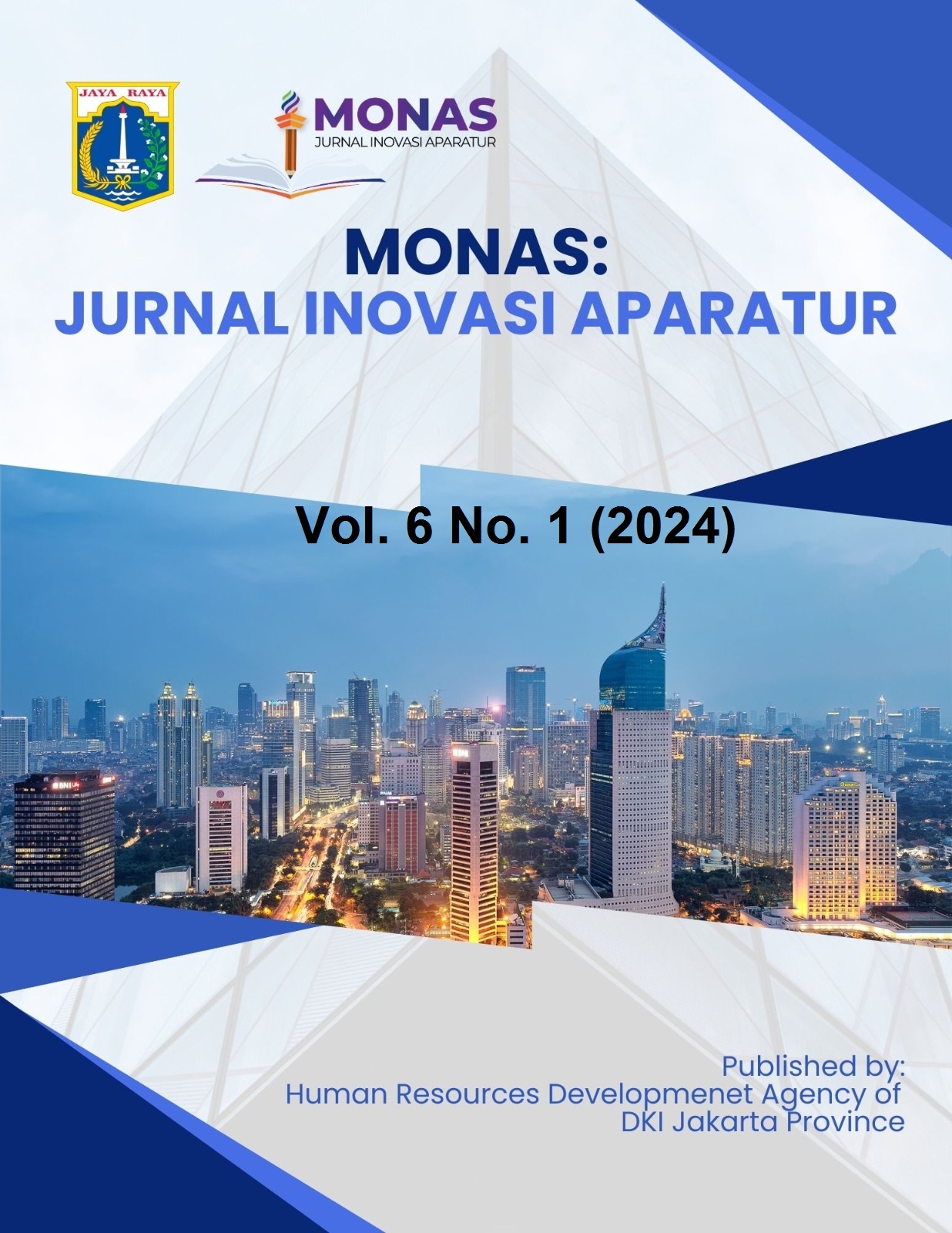From Pacing to Rapport
Building Communication with Generation Z in Smart City Laboratory
DOI:
https://doi.org/10.54849/monas.v6i1.214Keywords:
pacing, Rapport, Communication, Generation Z, smart cityAbstract
This research is part of a series of studies under the broad theme of "Smart-Pusdiklat'' within the National Cyber and Crypto Agency (BSSN). The research question addressed is how instructors use the Pacing Phase to Rapport to build communication in the learning process in the Smart City Laboratory. The study revealed that training participants, predominantly from Generation Z, faced challenges such as boredom, loss of focus, and difficulty making choices. Meanwhile, instructors involved were from Generation X and Y. The research highlights key considerations for instructors to ensure effective communication in the classroom. What aspects should instructors pay attention to in order to ensure effective and flawless communication in the classroom? This study employs an exploratory research method with a qualitative approach, aimed at exploring a new phenomenon that has not been previously researched. This is a novelty in the context of the Smart City Laboratory implementation. There are 4 (four) important aspects of the Pacing Phase that must be done to achieve Rapport: Active listening and engagement, Pacing Body Language and Breathing, Technology Integration, Connecting Learning Objectives to Real Life, and Short and Engaging Content, which aligns with the preferences and learning styles of generation Z.
References
Ahmad Muzaki. (2015). Studi Literatur Tentang “Pembelajaran dengan Teknik Hypnoteaching untuk Meningkatkan Self-Affirmation Matematis Mahasiswa. Prosiding Simposium Nasional Inovasi Dan Pembelajaran Sains , 1–4. https://bit.ly/rfspacing-muzaki
APTIKNAS. (2024, January 25). Smart City Talk : How Important Infrastructure Technology to Welcome the Smart City. APTIKNAS. https://www.aptiknas.id/2024/01/aptiknas-gelar-smart-city-talk-di-kota.html
Bandiera, O., Prat, A., Sadun, R., & Wulf, J. (2014). Span of Control and Span of Attention. SSRN Electronic Journal. https://doi.org/10.2139/ssrn.2392623
Biro Umum. Ditjen Perumahan. (2023). Skema Perumahan ASN di KIPP - IKN.
Bradbury, N. A. (2016). Attention span during lectures: 8 seconds, 10 minutes, or more? Advances in Physiology Education, 40(4), 509–513. https://doi.org/10.1152/advan.00109.2016
Cilliers, E. J. (2017). The challenge of teaching generation Z. PEOPLE International Journal of Social Sciences, 3, 188–198. https://doi.org/10.20319/pijss.2017.31.188198
Creswell, J. W. (2014). Research-Design. Qualitative, Quantitative and Mixed MethodsApproaches (U. Nebraska-Lincoln, Ed.; 4th ed.). Sage Publication Inc.
Farmer, S. S. (1983). SUPERVISORY CONFERENCES IN COMMUNICATIVE DISORDERS [University of Colorado]. https://www.proquest.com/openview/8c16d8a597e5700777ddd394a20bc48c/1?pq-origsite=gscholar&cbl=18750&diss=y#
Goldsmith, J. (2010). Pacing and time allocation at the micro- and meso-level within the class hour: Why pacing is important, how to study it, and what it implies for individual lesson planning. Bellaterra Journal of Teaching & Learning Language & Literature, 1(1), 30–48. https://doi.org/10.5565/rev/jtl3.34
GovInsider. (2024). About GovInsider. Govinsider.Asia. https://govinsider.asia/intl-en/about-govinsider
Harvard Medical School. (2020, July 6). Relaxation techniques: Breath control helps quell errant stress response. Harvard Health Publishing. https://www.health.harvard.edu/mind-and-mood/relaxation-techniques-breath-control-helps-quell-errant-stress-response
Hernandez-de-Menendez, M., Escobar Díaz, C. A., & Morales-Menendez, R. (2020). Educational experiences with Generation Z. International Journal on Interactive Design and Manufacturing (IJIDeM), 14(3), 847–859. https://doi.org/10.1007/s12008-020-00674-9
Jones, S. M., Bodie, G. D., & Hughes, S. D. (2019). The Impact of Mindfulness on Empathy, Active Listening, and Perceived Provisions of Emotional Support. Communication Research, 46(6), 838–865. https://doi.org/10.1177/0093650215626983
Maribel R. Diz. (2021). Gen Z and Millennials in The Workplace: How are leaders adapting to their short attention spans and How will they keep them from leaving a qualitative study [Florida International University]. https://digitalcommons.fiu.edu/cgi/viewcontent.cgi?article=6163&context=etd
McComb, S. A., & Kennedy, D. M. (2020). Team Communication in Theory and Practice. https://api.semanticscholar.org/CorpusID:214338765
McComb Sara and Kennedy, D. (2020). Timing and Pacing of Team Communication. In Computational Methods to Examine Team Communication: When and How to Change the Conversation (pp. 79–104). Springer International Publishing. https://doi.org/10.1007/978-3-030-36159-4_5
Moore, K., Jones, C., & Frazier, R. S. (2017). Engineering Education For Generation Z. American Journal of Engineering Education (AJEE), 8(2), 111–126. https://doi.org/10.19030/ajee.v8i2.10067
Petersen, S., Orth, B., & Ritz, T. (2008). Awareness of breathing: The structure of language descriptors of respiratory sensations. Health Psychology, 27(1), 122–127. https://doi.org/10.1037/0278-6133.27.1.122
Rodinova, N., Balyk, U., Korobko, Y., & Plekhanova, T. (2023). Brand Storytelling in the Age of Short Attention Spans: Strategies for Effective Communication. Marketing and Branding Research, 10, 1–16. https://doi.org/10.32038/mbr.2023.10.01.01
Sanalan, V. A., & Taşlıbeyaz, E. (2020). Discovering Turkish Generation-Z in the Context of Educational Technology. Journal of Educational Issues, 6(2), 249. https://doi.org/10.5296/jei.v6i2.17552
Seemiller, C., & Grace, M. (2017a). Generation Z: Educating and Engaging the Next Generation of Students. About Campus: Enriching the Student Learning Experience, 22(3), 21–26. https://doi.org/10.1002/abc.21293
Seemiller, C., & Grace, M. (2017b). Generation Z: Educating and Engaging the Next Generation of Students. About Campus: Enriching the Student Learning Experience, 22(3), 21–26. https://doi.org/10.1002/abc.21293
Sobandi, B. (2016). Modul Diklat Kewidyaiswaraan Berjenjang Tingkat Menengah. In Modul Diklat Kewidyaiswaraan Berjenjang Tingkat Menengah. Metode Penelitian II. . Lembaga Administrasi Negara. Pusat Pembinaan Widyaiswara.
Sugiyono. (2018). Metode penelitian kuantitatif, kualitatif dan kombinasi (mixed methods) (Alfabeta, Ed.; 19th ed., Vol. 10). Alfabeta. https://opac.perpusnas.go.id/DetailOpac.aspx?id=853411
Suprijandoko, F. (2017a). Studi Kasus Pendidikan SDM Aparatur : Upaya pencegahan keadaan Futur dengan menggunakan Metode Hypno-Andragogy Peserta Diklat Sandiman Dasar Angkatan 203 dan 204 Pada Pusdiklat Lemsaneg. Seminar Nasional Karya Tulis Ilmiah, 203–213. https://bit.ly/rfspacing-2017a
Suprijandoko, F. (2017b). Upaya peningkatan Self-Affirmation pada kelas Building Learning Commitment dalam Workshop Kesadaran Informasi bagi Pejabat Pemerintah Daerah dengan metode Hypnosis for Andragogy: Studi kasus pendidikan orang dewasa. Prosiding Seminar Nasional. Menuju Aparatur Berkelas Dunia. Badan Kepegawaian Dan Pengembangan Sumber Daya Manusia. , 1(1), 212–223. https://bit.ly/rfspacing-2017b
Suprijandoko, F. (2018). Hypno-Andragogy 2.0: Transformation of Learning Process Using Hypnosis Method in Andragogy Class. PEOPLE: International Journal of Social Sciences, 4(3), 196–207. https://doi.org/10.20319/pijss.2018.43.196207
Suprijandoko, F. (2020). Smart-Pusdiklat: Proyeksi Model Scenario Building and Planning Dalam Transformasi Pusdiklat BSSN. Jurnal Kewidyaiswaraan, 5(2), 55–61. https://doi.org/10.56971/jwi.v5i2.86
Suprijandoko, F. (2022a). Building Data Marts in Teaching Management: A Case Study. PUPIL: International Journal of Teaching, Education and Learning, 6(3), 01–14. https://doi.org/10.20319/pijtel.2022.63.0114
Suprijandoko, F. (2022b). Smart-Pusdiklat #1 Transformasi Digital di Dunia Pendidikan dan Pelatihan (1st ed., Vol. 1). PT. Nas Media Indonesia. Anggota IKAPI No. 018/SSL/2018. https://www.google.co.id/books/edition/SMART_Pusdiklat_1_Transformasi_Digital_d/m3d8EAAAQBAJ
Suprijandoko, F. (2023). Smart-Pusdiklat #2 Jalan Menuju Sekolah Cerdas. (F. Suprijandoko, Ed.; 1st ed., Vol. 1). Penerbit Nas Media Pustaka (Anggota IKAPI). https://bit.ly/rfspacing-buku2
Szymkowiak, A., Melović, B., Dabić, M., Jeganathan, K., & Kundi, G. S. (2021). Information technology and Gen Z: The role of teachers, the internet, and technology in the education of young people. Technology in Society, 65, 101565. https://doi.org/10.1016/j.techsoc.2021.101565
Wee, D. (2019). Generation Z talking: transformative experience in educational travel. Journal of Tourism Futures, 5(2), 157–167. https://doi.org/10.1108/JTF-02-2019-0019
Weger Jr., H., Castle Bell, G., Minei, E. M., & Robinson, M. C. (2014). The Relative Effectiveness of Active Listening in Initial Interactions. International Journal of Listening, 28(1), 13–31. https://doi.org/10.1080/10904018.2013.813234
Downloads
Published
Issue
Section
License
Authors who publish in this journal agree to the following terms:
- Authors retain copyright and grant the journal right of first publication with the work simultaneously licensed under a Creative Commons Attribution-NonCommercial-ShareAlike 4.0 International License that allows others to share the work with an acknowledgement of the work's authorship and initial publication in this journal.
- The journal allows the authors to hold the copyright without restrictions and to retain publishing rights without restrictions.
- Authors can enter into separate, additional contractual arrangements for the non-exclusive distribution of the journal's published version of the work (e.g., post it to an institutional repository or publish it in a book), with an acknowledgement of its initial publication in this journal.








